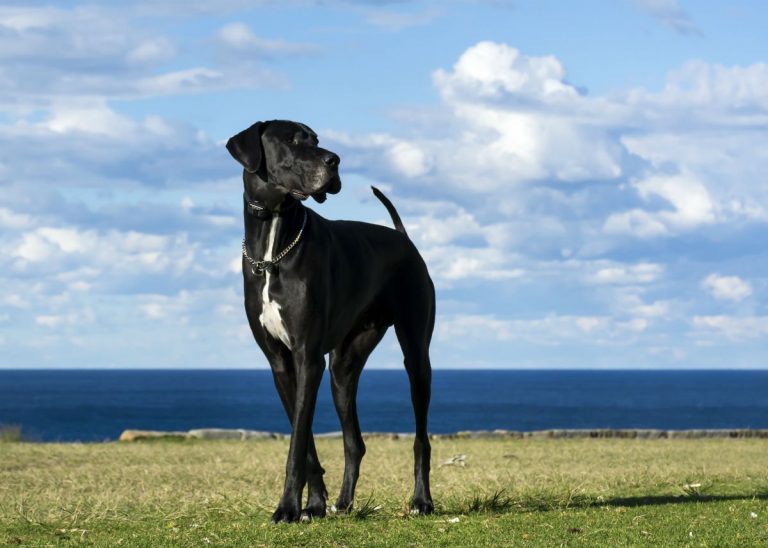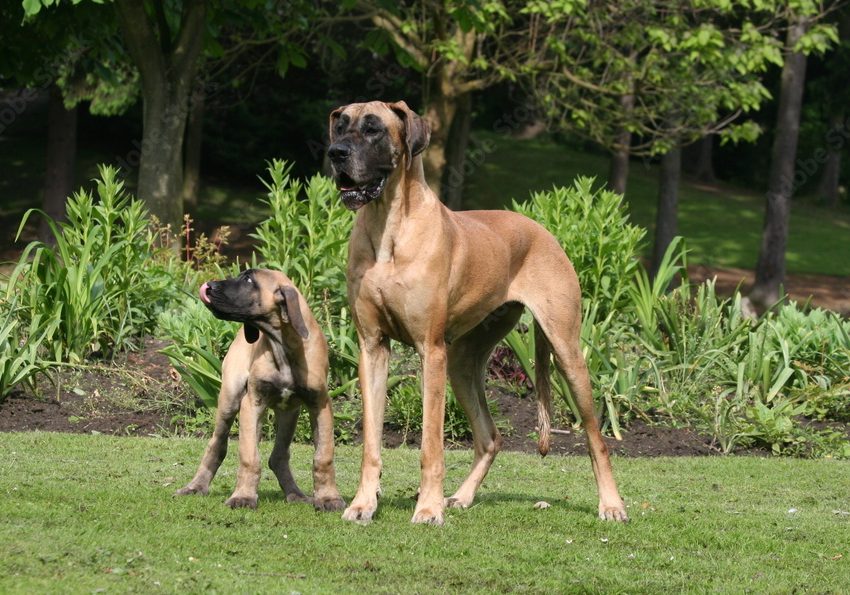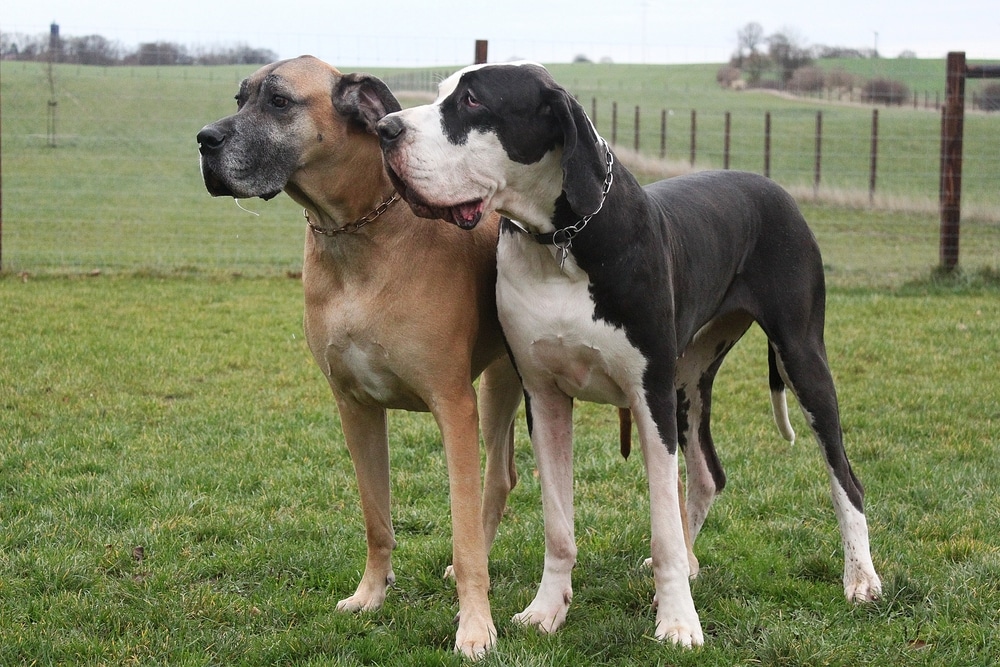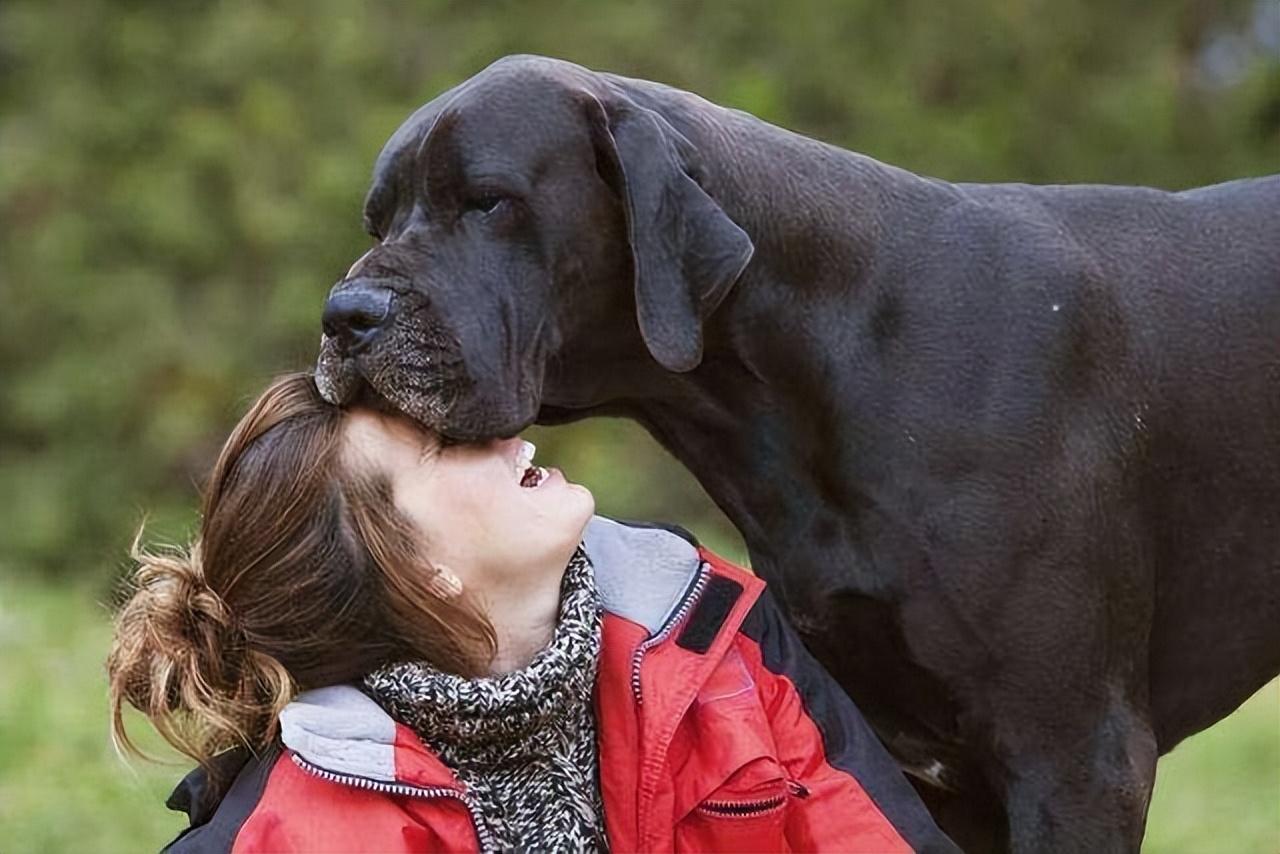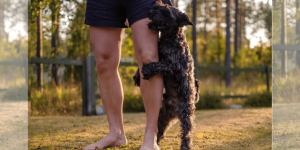When we say giant dog breeds, we think of dogs that weigh 100 pounds or more when fully grown. These are some of the tallest dogs in the canine world. At the same time, they are some of the most loving. The Great Dane, for example, has definitely earned the nickname of a gentle giant. How tall do Great Danes get?
These puppies can exceed 200 pounds in some cases, and their height is truly shocking. Most people think of them as the tallest breed in the world. Is that true? Some other contenders include the Irish Wolfhound and the English Mastiff. Let’s take a look.
How Tall Do Great Danes Get?
So, how tall exactly is a Great Dane from head to feet? There is a reason why these dogs are called the Apollo of Dogs. They have an impressive physique, gracefulness, and powerful appearance.
When measuring a dog, you do it from the tops of the shoulders to where the paws touch the ground. This is what you see on a breed’s height listing.
With that in mind, an average male Great Dane grows between 30 and 32 inches and weighs between 140 and 175 pounds. Females, of course, are a tad smaller. A female Great Dane grows between 28 and 30 inches from withers to paws and can weigh between 110 and 140 pounds.
According to the American Kennel Club, Great Danes are the tallest dogs in the world. And while they are massive in size, Danes are elegant and graceful canines.
A few other puppies can give the Great Dane a run for its money, but the Dane is the tallest.
Most dogs that have held the record for the tallest dog in the world have been Great Danes. For example, the tallest dog ever is Zeus, a Great Dane from Michigan, who measured 44 inches in 2011.
Freddy held the title of the tallest living dog up until 2021, measuring 40 inches.
Size And Growth Chart
As we said before, The American Kennel Club recognizes the Great Dane as the largest dog in the world. Not only are these dogs massive, but they also grow quickly. That is because Danes live short lives. They reach maturity quicker than most large dog breeds.
Age: 2 Months
Weight Range: Male 20–30 lbs; Female 15–25 lbs
Height Range: 13–18 inches
Age: 3 Months
Weight Range: Male 35–45 lbs; Female 25–35 lbs
Height Range: 17–23 inches
Age: 4 Months
Weight Range: Male 55–65 lbs; Female 45–55 lbs
Height Range: 21–26 inches
Age: 5 Months
Weight Range: Male 70–85 lbs; Female 60–75 lbs
Height Range: 23–30 inches
Age: 6 Months
Weight Range: Male 80–100 lbs; Female 65–80 lbs
Height Range: 26–33 inches
Age: 7 Months
Weight Range: Male 90–110 lbs; Female 70–90 lbs
Height Range: 27–34 inches
Age: 8 Months
Weight Range: Male 100–120 lbs; Female 80–100 lbs
Height Range: 27–35 inches
Age: 9 Months
Weight Range: Male 110–130 lbs; Female 85–105 lbs
Height Range: 28–35 inches
Age: 1 Year
Weight Range: Male 125–175 lbs; Female 100–130 lbs
Height Range: 29–36 inches
Adult Male
Weight Range: 135–170 lbs
Height Range: 33–36 inches
Adult Female
Weight Range: 110–145 lbs
Height Range: 30–34 Inches
When Do Great Danes Stop Growing?
Great Danes grow in spurts until they are eight months old. Following that period, their food intake usually decreases. It might seem like they have stopped growing. But they can grow an inch or two more until they are one year old. But from 8 months to 1 year, they grow at a slower pace.
Usually, Great Danes reach their full height when they are two years old. Until they reach their full height, their bodies continue to mature. Some of the changes you may notice are the following:
- The hips become wider and more developed
- Your dog’s chest gets fuller and deeper
- Muscles in the hips, thighs, and shoulders become more developed
- The head structure matures
- Your dog no longer looks puppyish
Factors That Affect The Size
When you ask the question of how tall Great Danes get, you have to take some factors into consideration. We saw the growth chart, but not every dog grows at the same pace. There are many facts that can affect the size of your Great Dane.
Feeding
For some people, the more the food, the faster the growth. But it doesn’t work that way. You should not overfeed your Great Dane and think it will grow faster. What you should do is follow a feeding schedule and use high-quality dog food.
Origin
You might not know this, but there is a European Great Dane and American Great Dane. And they differ in terms of size.
Generally speaking, the European Great Dane grows taller and leaner, with an elongated head and body.
Genetics
Of course, genetics play a role. Genetics determine the height, weight, and everything else about a Great Dane. And if you have a mixed breed, you have to take into consideration the genetics of the second parent as well.
Neutering
Neutered dogs reach heights bigger than the average number. You might be wondering why? Well, because when neutered, the growth plates remain open for a more extended period of time. This results in a significant increase in height.
It also affects your dog’s overall growth rate.
Should You Be Concerned If Your Dog Is Small?
Now, some people have a smaller Great Dane puppy than the average. And if your dog is smaller an inch or two than the average height, do not panic. You should not be concerned. There is nothing wrong with having a slightly smaller Great Dane.
Now, if your dog has a significant difference and is not meeting even the lower standard, then it might be time to do a checkup.
The Downside Of Being A Giant Dog
Not all is great with a giant breed like Great Dane. Giant dog breeds have a shorter lifespan because of the number of conditions that affect them. According to the AKC, this breed is one of the most problematic.
Large dog breeds often have skeletal dysplasia, resulting in abnormal development of their bones and joints. It makes it difficult for them to move around and even walk.
There are plenty of other issues that can cause problems in Great Danes, including cardiomyopathy and thyroid issues.
As a result, Danes are among the shortest-living dog breeds. Their average lifespan is between 8 and 10 years. Sadly, most of them live between 6 and 7 years.
The Gentle Giant
Despite its daunting size, the Great Dane puppy is highly affectionate and social. These puppies love to love. They need plenty of affection, and being around people and other animals. Danes are amazing family pets. They can function in a household with other pets, including cats.
Great Danes are also amazing with children, but because of their massive size, you should supervise their play.

